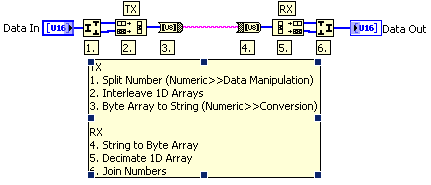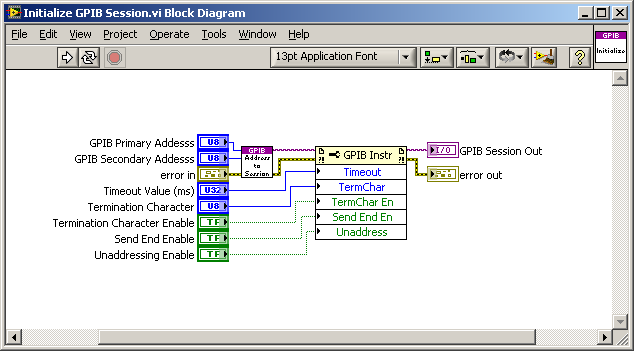-
Posts
549 -
Joined
-
Last visited
-
Days Won
25
Content Type
Profiles
Forums
Downloads
Gallery
Everything posted by crossrulz
-
I'll take stability over fancy new toys any day!
-
The most simple way would probably make another consumer loop for showing your non-modal dialog boxes. Have another queue (or notifier) running around to tell the loop to run a certain window. You would be limited to one dialog box opening in the new consumer, but it is a quick and easy way to handle your issue.
-
Shaun hit the big one. You need to properly shut down your system: turn power supplies, function generators, DIO, etc. off, reset other equipment, close out references and handles. The abort button will not do that. I have troubleshot a program where someone hit the abort button and ran again and wondered why the DIO port was not available (because it wasn't released from the previous run!). My experience, however, is mostly with non-LabVIEW people as my user and 99.9% of the time they do not see my giant Stop button (even though it is in the top right corner) and go straight for the Windows "X". If you don't handle this properly, the VI is still actually running even though you don't have a front panel. This will lead to a similar problem as just aborting. So I don't use Stop buttons anymore and just use an event structure and the "<This VI> Panel Close?" filter event. I discard the event, close up everything properly, and then shut down (if needed).
-
You can use a property node to set the Minimum and Maximum values of the control inside the array. All items in the array will have the same properties (not sure if you care about that).
-

Handling multiple versions of Reusable Library
crossrulz replied to LV User's topic in Source Code Control
I've was playing around with VIPM 2010 yesterday and found that I can now build all the packages I want with the free community version. There used to be limitations, but it looks like JKI decided to open it. Here are my major reasons to use VIPM: 1. It manages your user library for each version of LabVIEW you have installed, 2. You can define your palettes a lot more easily than using LabVIEW's palette editor, 3. You can install only which packets you need, 4. It handles packet dependencies (ex. my GPIB packet need my Wait packet in order to work). These are things a normal SCC just cannot do, or at least not cleanly. -

LabVIEWs response time during editing becomes so long
crossrulz replied to MikaelH's topic in LabVIEW General
So was I. Luckily Christina set me straight in her blog post. -

Handling multiple versions of Reusable Library
crossrulz replied to LV User's topic in Source Code Control
I have been looking into this for the last few months and VIPM is the only thing that I have found that will do this. And it does it well. -
NI will release a service pack in the spring. That's how their new software cycle is going to be starting with 2009.
-

Understanding a sub vi's error handling at a glance?
crossrulz replied to Daklu's topic in LabVIEW General
Darren explains them fairly well in one of his weekly nuggets. -
What exactly do you mean by "merge"? Are you looking for a 3D array or a concatenation? It really depends on what the data is and what you are doing with it (post processing algorithms, save to disk, etc.).
-
Have you looked at the Array Subset Function?
-
I feel your pain. What I ended up doing was copying the distribution DVDs onto my hard drive and then install from my hard drive. The installer builder looks at the location of the installer at the place the function was installed from. So since I installed from my hard drive, the installer builder found the location and didn't give me a pop up. Only do this if you have plenty of hard drive space (for obvious reasons). Another option might be to copy the DVDs onto a server and install from there. Haven't really tried that yet.
-
I have had good luck with SuperLogics. Finding motherboards with six PCI slots might be a challenge for any vendor though. Also make sure you get a computer that is at least 4U or else many of your PCI cards might not fit inside the case.
-

How to convert a 8 bits signal in 16 bits signal
crossrulz replied to leonardovieira's topic in LabVIEW General
Look in Numeric>>Data Manipulation to find Join Numbers and Split Number. Join Numbers will take two U8s and turn them into a U16. Split Number will do the opposite. If you are dealing with arrays of your 16bit data, you may want to also look at the Decimate 1D Array and Interleave 1D Arrays. -
I would have thought that you wanted Termination Character Enable to be set to FALSE. But I don't have the stuff in front of me. As long as the thing works. I honestly have not used the VISA Clear function. According to the help it just clears out the transfer buffers. It might be a good practice to use it after opening your VISA session, but definitely not necessary.
-
There is equipment out there that uses termination characters. I think by default VISA has termination characters on. The o-scope may be using what VISA thinks is a termination character as a separator for some reason. You can use a property node to change the VISA settings. You should check with Hameg, but it is likely you either need to disable termination characters or change the termination character.
-

Equal? Comparison on Strings - Compare Aggregates
crossrulz replied to asbo's topic in LabVIEW General
From the LabVIEW Help, it appears that the two modes only matter when comparing arrays or clusters. Do a search for "Using Comparison functions" or "Setting Comparison Functions to Compare Elements or Aggregates" for the official wording. -

Equal? Comparison on Strings - Compare Aggregates
crossrulz replied to asbo's topic in LabVIEW General
-

Strange Semaphore Behavior
crossrulz replied to theoneandonlyjim's topic in Application Design & Architecture
This might sound stupid, but are you sure you are running your "Initialize" state? -

How to split a string to decimal?
crossrulz replied to lovemachinez's topic in Application Design & Architecture
Are you passing the temperature values over the RS232 in an ASCII format or binary? If you are passing them in a binary format, I recommend the String to Byte Array. If you are passing them in an ASCII format, look at the String/Number Conversion palette (it's under the String palette). These can get your string into numbers to then put into the graph. -
That looks just like the test interface box I have to work with right now...
-
I don't. That's the reason I don't like the NI forum RSS feeds. I like seeing the responses in my RSS.






